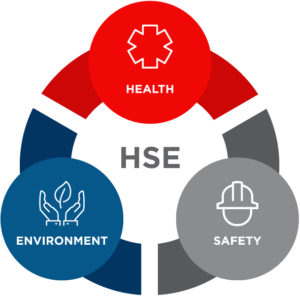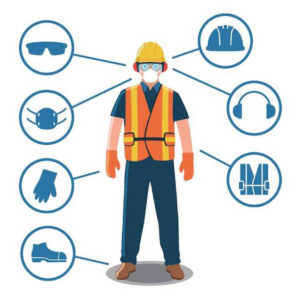HEALTH AND SAFETY ENVIRONMENT (HSE)
Maintaining outstanding Health, Safety and Environment (HSE) performance is a core value of ALMAJEEDYA Company. Our successful HSE performance has been made possible through the leadership and teamwork of all employees. Our HSE responsibilities are directed by our HSE Vision, Mission, and Policy, which guide our businesses in the development of their HSE processes.
ALMAJEEDYA Safety Philosophy
Safety is our core value and a cornerstone of our culture. We develop a safety program for every phase of every project evaluating the risks inherent in our type of work, from executive management to individual crew team members. We recognize that safety is a key focus not only from the project supervisor but by every employee on a project or in the office. Providing a safe work environment is each employee’s responsibility and ALMAJEEDYA’s first priority. Our safety program complies with all federal, state and local regulations, with an emphasis on the Occupational Safety and Health Act (OSHA) requirements for construction operations. We have a core set of safety training requirements that all field personnel must keep current and up-to-date. We also hold formal field and classroom safety training: Fall protection, excavation, confined space, forklift, aerial lift, and crane operation… etc. Corman maintains a corporate Safety Department staffed with certified, trained experts. This group is tasked with regular instruction follow up and field interaction to ensure that everyone understands supports and enforces ALMAJEEDYA’s safety philosophy and policies. As a result, Corman’s Experience Modification Rating is below the industry standard.

Construction Work Plan
We believe planning prevents incidents.
Prior to project mobilization, our crews and subcontractors create a comprehensive Construction Work Plan (CWP). This ALMAJEEDYA developed tool helps identify potential hazards of a particular scope of work and recommends the safest way to do the job. Throughout construction, subcontractors continue to complete CWPs for each new task.
Pre-Shift Safety Huddle
Our daily pre-shift safety huddle begins with Stretch and Flex, a program implemented at all ALMAJEEDYA project sites and offices to warm up muscles and help prevent soft-tissue injuries. It’s an energetic way for the entire team and office to start the day and build camaraderie. Stretch and Flex is followed by announcements from our project leadership team to communicate any potential hazards or share relevant toolbox talks. Ultimately, the pre-shift safety huddle is a daily reminder to put safety first.
Daily Hazard Analysis
The Pre-Shift Safety Huddle is followed by Daily Hazard Analysis (DHA) review, a 10- to a 15-minute documented conversation about the day’s activities, which includes discussion of each subcontractor’s CWP. This allows the entire project team to begin each day on the same page.
The DHA identifies the following:
- The day’s work activities
- Hazards associated with each work activity, including coordination with other crews around a work area
- The steps crews will take to avoid the identified hazards.
- If conditions change throughout the day, a new DHA must be completed. ALMAJEEDYA superintendents perform a daily worksite inspection to confirm that DHAs are completed and implemented.
Measuring Safety
We measure the effectiveness of our safety program using leading and lagging indicators. Lagging indicators, such as Incident Rates and Lost Time Accident Rates, capture industry-standard safety statistics. Achieving a culture that strives for zero incidents takes work before a shovel hits the ground, which is why we also focus on leading indicators.
Leading indicators are more consistent with Injury Free Environment and include such things as measuring full participation in Stretch and Flex, the number of people who are trained in IFE Orientation and a Supervisory Skills Workshop, as well as the number of Executive Site Safety Visits (ESSV) performed at job sites by ALMAJEEDYA leadership. Like a sports team that practices all the right things prior to a game, we believe embracing leading indicators will lead to the best performance in the field and lead to lower and lower lagging indicators, with the ultimate goal of zero.

Committed to worker safety from the top down
Leadership that inspires safe behavior is the foundation of an Injury-Free Environment. ALMAJEEDYA executives conduct Executive Site Safety Visits (ESSV) to demonstrate the importance of visible leadership throughout the organization. In Iraq, ALMAJEEDYA leaders conduct many formal ESSVs every year to promote the safest working environment possible.
Safety Week
Since 2004, ALMAJEEDYA has held an annual Safety Week to focus its entire business on safety awareness.
At more than 5,000 job site worldwide, ALMAJEEDYA’s employees and hundreds of clients, subcontractors, suppliers, and business partners are involved in activities focused on safety. Activities include hundreds of safety visits to worksites by senior ALMAJEEDYA leadership; extensive training programs for employees, subcontractors and business partners related to safety; and programs that focus on health, such as training in first aid and routine health screenings.
Industry Safety Week
Our industry has come together to show its shared commitment to eliminating incidents. ALMAJEEDYA helped found the annual Construction Industry Safety Week, together with many national and global construction firms comprising The Construction Industry Safety (CISI) group and the Incident and Injury Free CEO (IIF) Forum. The group has a single aim: to inspire everyone in the industry to be leaders in safety.
Subcontractor Management
As part of our safety management program, we partner with our subcontractors to heighten awareness of the risks workers face every day. Our goal is to change the workforce culture from “Incidents won’t happen to me,” to “I can prevent incidents before they happen.” We actively foster an environment in which all workers take care of one another and feel free to speak up about safety.
Prequalify
In order to bid on ALMAJEEDYA project, all subcontractors must prequalify by meeting specific safety requirements, including:
- A comprehensive safety program
- An active safety training program
- Zero fatalities in the previous three years
- Zero serious OSHA citations in the previous three years.
Injury-Free Environment: Making safety personnel
While comprehensive and robust systems are essential to ensuring safety on our job sites, cultivating an Injury-Free Environment (IFE) that inspires safe behavior is key to reaching our goal of zero incidents.
For more than a decade, ALMAJEEDYA has sought to create an IFE culture throughout its business. Based on our Care for Life value, IFE is the shared corporate and individual belief that safety must never be compromised for cost or schedule. The program is designed to create for all workers a mind-set intolerant of any frequency or severity of incident or injury: everyone has the right to go home safely at the end of the day.
All employees and everyone on our projects, from craft workers to customers, have ownership of the safety program and are held accountable for its implementation. The core principles of our IFE philosophy are:
- All incidents and injuries are preventable
- Injury-free operations are possible in the construction
- Safety awareness is personalized every day
- Each worker is empowered and accountable to stop any unsafe act or condition on the job site.
Training
Subcontractor workers entering our job sites attend IFE orientation, which focuses on workers’ personal relationship to safety. Subcontractor supervisors are encouraged to attend our Supervisory Skills Workshop, which focuses on three skills:
- Assigning injury-free work
- Recognizing and reinforcing safe work
- Constructively correcting at-risk work.
Courses are led by specially trained members of ALMAJEEDYA project team and are offered as close to the start of construction as possible. We evaluate orientations and training periodically to verify they are being properly conducted and that the contents adequately cover the standards, policies, rules, and procedures contained in the EHS Manual and OSHA standards.
Plan for safety
During construction, each subcontractor team develops a Construction Work Plan for every major task they are to complete. Additionally, each team member is expected to actively participate in our Pre-Shift Safety Huddle and Daily Hazard Analysis planning.

Global health and safety standards

To facilitate greater commonality in performance across all ALMAJEEDYA business units, sixteen Global Health and Safety Standards have been put in place, spanning from training to audits.
- Introduction training for all employees
- Incident management
- Risk assessment
- Personal protective equipment
- Management of vehicles on site
- Overhead /underground services
- Electrical safety
- Working at height
- Temporary work structures
- Excavation and trenching
- Lifting operations
- Confined Spaces
- Fire prevention
- Fixed facilities
- Safe management of goods
- Safety audit
